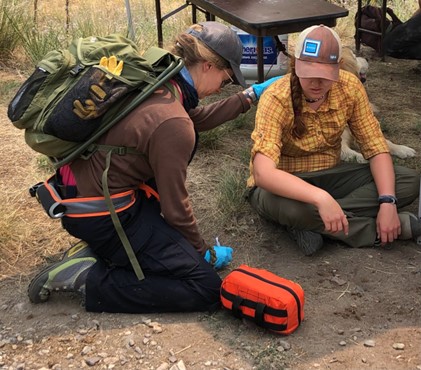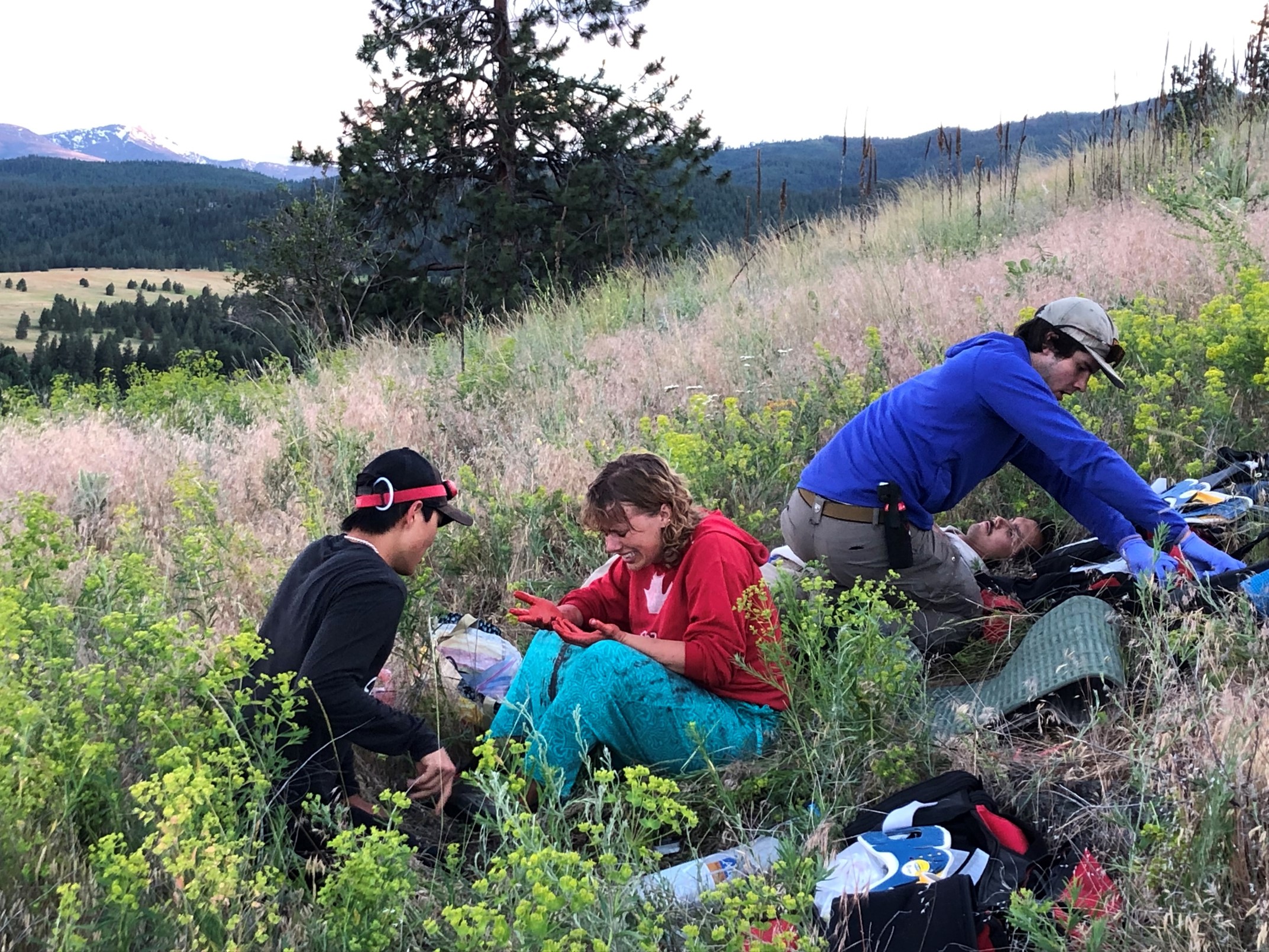
“Waterfall” by Frank Zuccala
Wilderness medicine education programs strive to provide students with comprehensive training in management of medical emergencies in austere environments. However, despite the rising rate of mental illness and psychiatric emergencies, wilderness medicine curricula may not have adjusted to deliberately train wilderness responders for crisis intervention in the backcountry. While the etiologies of psychiatric emergencies are multifactorial and complicated, the basic skills of crisis intervention are relatively simple and should be acquired within the confines of wilderness medical education, particularly at the first responder and technician levels. Without a shift in focus to improve wilderness psychiatric emergency care, patients encountered in the outdoor recreation and expedition environments will fail to receive the evidence-based care that they deserve from well-trained wilderness medicine practitioners.
Following the COVID-19 pandemic, and the resulting aftermath, there has been a measurable change in the incidence of mental illness, particularly in children and adolescents. More patients are experiencing crises, with relatively fewer resources and access to mental health resources. Moreover, there has also been a troubling rise in the rates of suicide in the US. The medical community is attempting to address these shifts to better care for patients suffering from mental health struggles by enhancing access and adopting new and sometimes novel therapeutic interventions. Nature therapy and other similar outdoor recreation programs are novel evidence-based therapeutic approaches to mental health struggles that have been increasing in popularity. As a result, hunting guides, wilderness trip leaders, park rangers, and others in the outdoor industry may have increased contact with those combating mental illness and may have to intervene in a mental health crisis.
In addition to the need to be able to assess and treat psychiatric emergencies in patients, wilderness responders must also be aware that they themselves work in strenuous conditions and as such are susceptible to burn-out, anxiety disorders, and posttraumatic stress. Thus, the need to train in self-care and team care is important as well. The ability to recognize acute or chronic stress reactions in oneself, or a teammate, is not only helpful for the treatment and recovery but may be a critical step in ensuring safe operation in a wilderness medical environment. If one or more team members on a wilderness medical team are becoming emotionally or psychologically fatigued or injured and these injuries are not recognized and addressed, it could significantly jeopardize the team’s safety as well as the patient’s.

Students practicing assessment and PFA (Frank Zuccala)
Many wilderness first responder (WFR) and wilderness emergency medical technician (WEMT) programs have blocks of instruction regarding psychological first aid and psychiatric emergencies within the curricula. However, these are often an hour or less of instruction on what is a potentially life-threatening emergency that often shows no outward sign of advancement until the patient is in a crisis state. Even within the venerable Fellowship in the Academy of Wilderness Medicine (FAWM) of the Wilderness Medicine Society there is but a single core topic area in the curriculum and three topic areas in the electives section, that attempt to address psychiatric emergencies. While the spectrum of wilderness medicine is so vast that one cannot expect to become a clinical expert in all areas at once, psychiatric emergencies occur with such frequency and urgency that more focus is needed on training wilderness medicine practitioners in this area.
In many high volume emergency medical services (EMS) agencies, there have been increasing efforts to provide a co-response of emergency medical responders and mental health professionals (MHP). This enhances the skill level and overall proficiency of the care providers responding to calls for service related to mental health crises. This model is not feasible in a wilderness setting for obvious reasons, but it shows that urban EMS is recognizing and responding to the need to adapt to the rising tide of mental illness nationally. In order to provide wilderness medical practitioners with the skills necessary to adequately respond to crises in the backcountry, in-class didactic and scenario-based learning events should be incorporated into all initial and refresher courses for wilderness responders.
Didactic education for wilderness medical practitioners should include a brief survey of common mental health disorders, their manifestations, and strategies to intervene in acute exacerbation of these disorders. Additionally, lectures should cover the use of de-escalation skills, psychological first aid, psychological recovery, self-care and team-care. Multiple scenario-based learning events should help students with the incorporation of these skills into their standard assessment and intervention with all patients, not just those suffering from mental illness. Suicide risk assessment and evidence-based interventions should be covered in all wilderness medicine courses. Lastly, continuing education should be encouraged in all wilderness medicine practitioners in high yield areas, including psychiatric emergencies.
Example Psychiatric Emergency Scenario for WFA/WFR/WEMT Courses:
Setting: Backcountry Hiking Trip (Multi-day)
Responders: 1-3 WFA/WFR/WEMT
Initiation: Hikers on the trip report that the patient is increasingly withdrawn over the last couple days and has been heard talking about suicide. This morning, the patient was heard calling a friend and saying “goodbye” stating that they “will not be coming home.”
Patient:
Chief Complaint: Active suicidal ideation (without specific plan/means)
Primary Assessment: no apparent physiologic life threats
S - Active suicidal ideation (without formed plan/means), depressed mood, diminished appetite, increased fatigue, recurrent thoughts of death, hypersomnia
A – No known drug allergies
M - Zoloft (100mg/day), Valium (5mg, up to four times daily), Hydroxyzine (25mg, up to 4 times daily, CBD gummies, multivitamin.
P - Major Depression x 3 months
L - Hasn’t eaten in 2 days, minimal water intake, output diminished accordingly
E - Patient’s spouse died exactly one year ago today, anniversary hit them harder than expected
Physical Exam: Unremarkable
Vitals: as found on role player
Suggested Interventions: Use of active listening skills, Psychological Fist Aid skills, suicide risk assessment, and referral/transport (with possible remote medical direction) to nearest ED for immediate definitive care.
|
Above is an example scenario that could be used in training for WFA, WFR, or WEMT students to enhance their experience in the recognition, assessment, and intervention in psychiatric emergencies. Many wilderness medicine courses are already so compressed, that to add the suggested training would lead to the removal of other important material, or the insufficient coverage of the material added. Therefore, when students are not provided the necessary training in assessment, recognition and management of psychiatric emergencies, they should seek out additional training courses. A few high quality courses that cover this life-saving material include Applied Suicide Intervention Skills Training (ASIST), Psychological First Aid (PFA), Skills for Psychological Recovery (SPR), and Crisis Negotiation Skills for First Responders. Highly motivated wilderness medicine students wanting to achieve a high level of proficiency in this topic area can attend the 40-hour Crisis Intervention Training courses available to emergency responders. Within these and other courses, students can acquire knowledge, skills and abilities that may save lives in the backcountry on professional wilderness trips or on personal travel.
Wilderness medical education is among the most fun to acquire and most demanding to utilize because of the inherent difficulty for caring for patients with limited resources in austere environments. Understanding the inherent limitations of wilderness medicine is part of the education. So too is recognizing that skills are weightless and take up zero space in your pack. Hence, the continued acquisition of life-saving skills is incumbent upon all who claim to be wilderness medical providers. Furthermore, wilderness medical educators must live up to the ethos of adaptation and evolution common to wilderness medicine by prioritizing the assessment, recognition, and response to mental health crises in all levels of training.

WEMT students (Frank Zuccala)